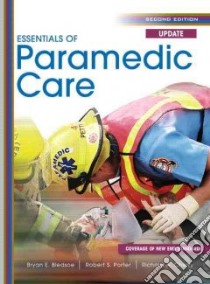Essentials of Paramedic Care Update - 9780132156899
Un libro in lingua di Bledsoe Bryan E. Porter Robert S. Cherry Richard A. edito da Pearson, 2010
- € 228.80
- Il prezzo è variabile in funzione del cambio della valuta d’origine
It is the intent of the authors and publishers that this textbook be used as part of a formal paramedic education program taught by a qualified instructor and supervised by a licensed physician. The care procedures presented here represent accepted practices in the United States. They are not offered as a standard of care. Paramedic-level emergency care is to be performed only under the authority and guidance of a licensed physician. It is the reader's responsibility to know and follow local care protocols as provided by medical advisors directing the system to which he or she belongs. Also, it is the reader's responsibility to stay informed of emergency care procedure changes.
Every effort has been made to ensure that the drug dosages presented in this textbook are in accordance with nationally accepted standards. When applicable, the dosages and routes are taken from the American Heart Association's Advanced Cardiac Life Support Guidelines. The American Medical Association's publication Drug Evaluations, the Physicians' Desk Reference, and the Prentice Hall Health Professional's Drug Guide are followed with regard to drug dosages not covered by the American Heart Association's guidelines. It is the responsibility of the reader to be familiar with the drugs used in his or her system, as well as the dosages specified by the medical director. The drugs presented in this book should only be administered by direct order, whether verbally or through accepted standing orders, of a licensed physician.
The English language has historically given preference to the male gender. Among many words, the pronouns "he" and "his" are commonly used to describe both genders. Society evolves faster than language, and the male pronouns still predominate in our speech. The authors have made great effort to treat the two genders equally, recognizing that a significant percentage of paramedics and patients are female. However, in some instances, male pronouns may be used to describe both male and female paramedics and patients solely for the purpose of brevity. This is not intended to offend any readers of the female gender.
Please note that many of the photographs contained in this book are taken of actual emergency situations. As such, it is possible that they may not accurately depict current, appropriate, or advisable practices of emergency medical care. They have been included for the sole purpose of giving general insight into real-life emergency settings.
Informazioni bibliografiche
- Titolo del Libro in lingua: Essentials of Paramedic Care Update
- Lingua: English
- Autori : Bledsoe Bryan E. Porter Robert S. Cherry Richard A.
- Editore: Pearson
- Collana: Pearson (Hardcover)
- Data di Pubblicazione: 07 Maggio '10
- Genere: MEDICAL
- Argomenti : Emergency medicine Emergency medical technicians Emergency Treatment methods
- Pagine: 2012
- Dimensioni mm: 279 x 222 x 69
- ISBN-10: 013215689X
- EAN-13: 9780132156899


